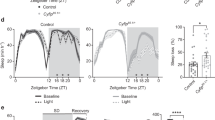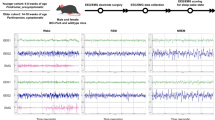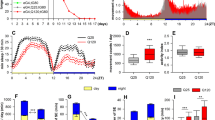Abstract
Insomnia is the most common sleep disorder among adults, especially affecting individuals of advanced age or with neurodegenerative disease. Insomnia is also a common comorbidity across psychiatric disorders. Cognitive behavioral therapy for insomnia (CBT-I) is the first-line treatment for insomnia; a key component of this intervention is restriction of sleep opportunity, which optimizes matching of sleep ability and opportunity, leading to enhanced sleep drive. Despite the well-documented efficacy of CBT-I, little is known regarding how CBT-I works at a cellular and molecular level to improve sleep, due in large part to an absence of experimentally-tractable animals models of this intervention. Here, guided by human behavioral sleep therapies, we developed a Drosophila model for sleep restriction therapy (SRT) of insomnia. We demonstrate that restriction of sleep opportunity through manipulation of environmental cues improves sleep efficiency in multiple short-sleeping Drosophila mutants. The response to sleep opportunity restriction requires ongoing environmental inputs, but is independent of the molecular circadian clock. We apply this sleep opportunity restriction paradigm to aging and Alzheimer’s disease fly models, and find that sleep impairments in these models are reversible with sleep restriction, with associated improvement in reproductive fitness and extended lifespan. This work establishes a model to investigate the neurobiological basis of CBT-I, and provides a platform that can be exploited toward novel treatment targets for insomnia.
This is a preview of subscription content, access via your institution
Access options
Subscribe to this journal
Receive 12 print issues and online access
$259.00 per year
only $21.58 per issue
Buy this article
- Purchase on Springer Link
- Instant access to full article PDF
Prices may be subject to local taxes which are calculated during checkout





Similar content being viewed by others
References
Dement W, Pelayo R. Public health impact and treatment of insomnia. Eur Psychiatry. 1997;12:31s–9s.
Ozminkowski RJ, Wang S, Walsh JK. The direct and indirect costs of untreated insomnia in adults in the United States. Sleep. 2007;30:263–73.
Daley M, Morin CM, LeBlanc M, Grégoire JP, Savard J, Baillargeon L. Insomnia and its relationship to health-care utilization, work absenteeism, productivity and accidents. Sleep Med. 2009;10:427–38.
Sarsour K, Morin CM, Foley K, Kalsekar A, Walsh JK. Association of insomnia severity and comorbid medical and psychiatric disorders in a health plan-based sample: insomnia severity and comorbidities. Sleep Med. 2010;11:69–74.
Qaseem A, Kansagara D, Forciea MA, Cooke M, Denberg TD, Barry MJ, et al. Management of chronic insomnia disorder in adults: a clinical practice guideline from the American college of physicians. Ann Intern Med. 2016;165:125–33.
Miller CB, Espie CA, Epstein DR, Friedman L, Morin CM, Pigeon WR, et al. The evidence base of sleep restriction therapy for treating insomnia disorder. Sleep Med Rev. 2014;18:415–24.
Spielman AJ. Assessment of insomnia. Clin Psychol Rev. 1986;6:11–25.
Morin CM, LeBlanc M, Daley M, Gregoire JP, Mérette C. Epidemiology of insomnia: prevalence, self-help treatments, consultations, and determinants of help-seeking behaviors. Sleep Med. 2006;7:123–30.
Trauer JM, Qian MY, Doyle JS, Rajaratnam SMW, Cunnington D. Cognitive behavioral therapy for chronic insomnia: a systematic review and meta-analysis. Ann Intern Med. 2015;163:191–204.
Wu JQ, Appleman ER, Salazar RD, Ong JC. Cognitive behavioral therapy for insomnia comorbid with psychiatric and medical conditions a meta-analysis. JAMA Intern Med. 2015;175:1461–72.
Sivertsen B, Vedaa Ø, Nordgreen T. The future of insomnia treatment—the challenge of implementation. Sleep. 2013;36:303–4.
Kathol RG, Arnedt JT. Cognitive behavioral therapy for chronic insomnia: confronting the challenges to implementation. Ann Intern Med. 2016;165:149–50.
Mitchell MD, Gehrman P, Perlis M, Umscheid CA. Comparative effectiveness of cognitive behavioral therapy for insomnia: a systematic review. BMC Fam Pract. 2012;13:40. https://doi.org/10.1186/1471-2296-13-40.
Roth T. Insomnia: definition, prevalence, etiology, and consequences. J Clin Sleep Med. 2007;3:S7–10. https://doi.org/10.1378/chest.14-0970.
Toth LA, Bhargava P. Animal models of sleep disorders. Comp Med. 2013;63:91–104.
Cirelli C, Bushey D, Hill S, Huber R, Kreber R, Ganetzky B, et al. Reduced sleep in Drosophila Shaker mutants. Nature. 2005;434:1087–92.
Koh K, Joiner WJ, Wu MN, Yue Z, Smith CJ, Sehgal A. Identification of SLEEPLESS, a sleep-promoting factor. Science. 2008;321:372–6.
Bushey D, Huber R, Tononi G, Cirelli C. Drosophila Hyperkinetic mutants have reduced sleep and impaired memory. J Neurosci. 2007;27:5384–93.
Stavropoulos N, Young MW. insomniac and Cullin-3 regulate sleep and wakefulness in Drosophila. Neuron. 2011;72:964–76.
Kume K, Kume S, Park SK, Hirsh J, Jackson FR. Dopamine is a regulator of arousal in the fruit. J Neurosci. 2005;25:7377–84.
Bushey D, Hughes Ka, Tononi G, Cirelli C. Sleep, aging, and lifespan in Drosophila. BMC Neurosci. 2010;11:56.
Zhang S, Yin Y, Lu H, Guo A. Increased dopaminergic signaling impairs aversive olfactory memory retention in Drosophila. Biochem Biophys Res Commun. 2008;370:82–86.
Seugnet L, Suzuki Y, Thimgan M, Donlea J, Gimbel SI, Gottschalk L, et al. Identifying sleep regulatory genes using a Drosophila model of insomnia. J Neurosci. 2009;29:7148–57.
Robertson M, Keene AC. Molecular mechanisms of age-related sleep loss in the fruit fly—a mini-review. Gerontology. 2013;59:334–9.
Hasan S, Dauvilliers Y, Mongrain V, Franken P, Tafti M. Age-related changes in sleep in inbred mice are genotype dependent. Neurobiol Aging. 2012;33:195.e13–26. https://doi.org/10.1016/j.neurobiolaging.2010.05.010.
Mander BA, Winer JR, Walker MP. Sleep and human aging. Neuron. 2017;94:19–36.
Kang JE, Lim MM, Bateman RJ, Lee JJ, Smyth LP, Cirrito JR, et al. Amyloid-B dynamics are regulated by orexin and the sleep-wake cycle. Science. 2009;326:1005–7.
Roh JH, Huang Y, Bero AW, Kasten T, Stewart FR, Bateman RJ, et al. Disruption of the sleep-wake cycle and diurnal fluctuation of beta-amyloid in mice with Alzheimer’s disease pathology. Sci Transl Med. 2012;4:150ra122.
Ju YE, Lucey BP, Holtzman DM. Sleep and Alzheimer disease pathology—a bidirectional relationship. Nat Rev Neurol. 2014;10:115–9.
Tabuchi M, Lone SR, Liu S, Liu Q, Zhang J, Spira AP, et al. Sleep interacts with aβ to modulate intrinsic neuronal excitability. Curr Biol. 2015;25:702–12.
Iijima K, Liu HP, Chiang AS, Hearn SA, Konsolaki M, Zhong Y. Dissecting the pathological effects of human Aβ40 and Aβ42 in Drosophila: a potential model for Alzheimer’s disease. Proc Natl Acad Sci USA. 2004;101:6623–8.
Dissel S, Klose M, Donlea J, Cao L, English D, Winsky-Sommerer R, et al. Enhanced sleep reverses memory deficits and underlying pathology in drosophila models of Alzheimer’s disease. Neurobiol Sleep Circadian Rhythm. 2017;2:15–26.
Saarelainen L, Tolppanen A, Koponen M, Tanskanen A, Tiihonen J, Hartikainen S, et al. Risk of death associated with new benzodiazepine use among persons with Alzheimer disease: a matched cohort study. Int J Geriatr Psychatry. 2018;33:583–90.
Krystal AD, Edinger JD. Sleep EEG predictors and correlates of the response to cognitive behavioral therapy for insomnia. Sleep. 2010;33:669–77.
Riemann D, Perlis ML. The treatments of chronic insomnia: a review of benzodiazepine receptor agonists and psychological and behavioral therapies. Sleep Med Rev. 2009;13:205–14.
Cassidy-Eagle E, Siebern A, Unti L, Glassman J, O’Hara R. Neuropsychological functioning in older adults with mild cognitive impairment and insomnia randomized to CBT-I or control group. Clin Gerontol 2018; 41: 136–144.
Crowther DC, Kinghorn KJ, Miranda E, Page R, Curry JA, Duthie FA, et al. Intraneuronal Aβ, non-amyloid aggregates and neurodegeneration in a Drosophila model of Alzheimer’s disease. Neuroscience. 2005;132:123–35.
Gilestro GF. Video tracking and analysis of sleep in Drosophila melanogaster. Nat Protoc. 2012;7:995–1007.
Gilestro GF, Cirelli C. PySolo: a complete suite for sleep analysis in Drosophila. Bioinformatics. 2009;25:1466–7.
Kayser MS, Yue Z, Sehgal A. A critical period of sleep for development of courtship circuitry and behavior in Drosophila. Science. 2014;344:269–74.
Dilley LC, Vigderman A, Williams CE, Kayser MS. Behavioral and genetic features of sleep ontogeny in Drosophila. Sleep. 2018;41. https://doi.org/10.1093/sleep/zsy086.
Hendricks JC, Finn SM, Panckeri KA, Chavkin J, Williams JA, Sehgal A, et al. Rest in Drosophila is a sleep-like state. Neuron. 2000;25:129–38.
Shaw PJ, Cirelli C, Greenspan RJ, Tononi G. Correlates of sleep and waking in Drosophila melanogaster. Science. 2000;287:1834–7.
Sateia MJ, Doghramji K, Hauri PJ, Morin CM. Evaluation of chronic insomnia. an American Academy of Sleep Medicine review. Sleep. 2000;23:243–308.
Konopka RJ, Benzer S. Clock mutants of Drosophila melanogaster. Proc Natl Acad Sci USA. 1971;68:2112–6.
Kyle SD, Aquino MRJ, Miller CB, Henry AL, Crawford MR, Espie CA, et al. Towards standardisation and improved understanding of sleep restriction therapy for insomnia disorder: a systematic examination of CBT-I trial content. Sleep Med Rev. 2015;23:83–88.
Majercak J, Sidote D, Hardin PE, Edery I. How a circadian clock adapts to seasonal decreases in temperature and day length. Neuron. 1999;24:219–30.
Shi M, Yue Z, Kuryatov A, Lindstrom JM, Sehgal A. Identification of Redeye, a new sleep- regulating protein whose expression is modulated by sleep amount. Elife. 2014;3:e01473.
Liu S, Lamaze A, Liu Q, Tabuchi M, Yang Y, Fowler M, et al. WIDE AWAKE mediates the circadian timing of sleep onset. Neuron. 2014;82:151–66.
Edinger JD, Wohlgemuth WK, Radtke RA, Marsh GR, Quillian RE. Cognitive behavioral therapy for treatment of chronic primary insomnia: a randomized controlled trial. JAMA. 2001;285:1856–64.
Smith MT, Perlis ML, Park A, Smith MS, Pennington J, Giles DE, et al. Comparative meta-analysis of pharmacotherapy and behavior therapy for persistent insomnia. Am J Psychiatry. 2002;159:5–11.
Edinger JD, Wohlgemuth WK, Radtke RA, Coffman CJ, Carney CE. Dose-response effects of cognitive-behavioral insomnia therapy: a randomized clinical trial. Sleep. 2007;30:203–12.
Qiu J, Hardin PE. per mRNA cycling is locked to lights-off under photoperiodic conditions that support circadian feedback loop function. Mol Cell Biol. 1996;16:4182–8.
Okamoto-Mizuno K, Mizuno K. Effects of thermal environment on sleep and circadian rhythm. J Physiol Anthropol. 2012;31:1–9.
Kaneko H, Head LM, Ling J, Tang X, Liu Y, Hardin PE, et al. Circadian rhythm of temperature preference and its neural control in Drosophila. Curr Biol. 2012;22:1851–7.
Luo W, Chen WF, Yue Z, Chen D, Sowcik M, Sehgal A, et al. Old flies have a robust central oscillator but weaker behavioral rhythms that can be improved by genetic and environmental manipulations. Aging Cell. 2012;11:428–38.
Ishimoto H, Lark A, Kitamoto T. Factors that differentially affect daytime and nighttime sleep in Drosophila melanogaster. Front Neurol. 2012;3:24.
Parisky KM, Agosto Rivera JL, Donelson NC, Kotecha S, Griffith LC. Reorganization of sleep by temperature in Drosophila requires light, the homeostat, and the circadian clock. Curr Biol. 2016;26:882–92.
Matthews EE, Arnedt JT, McCarthy MS, Cuddihy LJ, Aloia MS. Adherence to cognitive behavioral therapy for insomnia: a systematic review. Sleep Med Rev. 2013;17:453–64.
Yoshii T, Hermann-Luibl C, Helfrich-Forster C. Circadian light-input pathways in Drosophila. Commun Integr Biol. 2015;9:e1102805. https://doi.org/10.1080/19420889.2015.1102805.
Helfrich-Förster C, Winter C, Hofbauer A, Hall JC, Stanewsky R. The circadian clock of fruit flies is blind after elimination of all known photoreceptors. Neuron. 2001;30:249–61.
Emery P, So WV, Kaneko M, Hall JC, Rosbash M. Cry, a Drosophila clock and light-regulated cryptochrome, is a major contributor to circadian rhythm resetting and photosensitivity. Cell. 1998;95:669–79.
Emery P, Stanewsky R, Helfrich-Förster C, Emery-Le M, Hall JC, Rosbash M. Drosophila CRY is a deep brain circadian photoreceptor. Neuron. 2000;26:493–504.
Agrawal P, Houl JH, Gunawardhana KL, Liu T, Zhou J, Zoran MJ, et al. Drosophila CRY entrains clocks in body tissues to light and maintains passive membrane properties in a non-clock body tissue independent of light. Curr Biol. 2017;27:2431–41.e3.
Koh K, Evans JM, Hendricks JC, Sehgal A. A Drosophila model for age-associated changes in sleep:wake cycles. Proc Natl Acad Sci USA. 2006;103:13843–7.
Brown MK, Chan MT, Zimmerman JE, Pack AI, Jackson NE, Naidoo N. Aging induced endoplasmic reticulum stress alters sleep and sleep homeostasis. Neurobiol Aging. 2014;35:1431–41.
Vienne J, Spann R, Guo F, Rosbash M. Age-related reduction of recovery sleep and arousal threshold in Drosophila. Sleep. 2016;39:1613–24.
Pandi-Perumal SR, Seils LK, Kayumov L, Ralph MR, Lowe A, Moller H, et al. Senescence, sleep, and circadian rhythms. Ageing Res Rev. 2002;1:559–604.
Curtsinger JW. Late-life fecundity plateaus in Drosophila melanogaster can be explained by variation in reproductive life spans. Exp Gerontol. 2013;48:1338–42.
Potdar S, Daniel DK, Thomas FA, Lall S, Sheeba V. Sleep deprivation negatively impacts reproductive output in Drosophila melanogaster. J Exp Biol. 2018;221:jeb174771.
Finelli A, Kelkar A, Song HJ, Yang H, Konsolaki M. A model for studying Alzheimer’s Aβ42-induced toxicity in Drosophila melanogaster. Mol Cell Neurosci. 2004;26:365–75.
Nilsberth C, Westlind-danielsson A, Eckman CB, Condron MM, Axelman K, Forsell C, et al. The ‘Arctic’ APP mutation (E693G) causes Alzheimer’ s disease by enhanced A β protofibril formation. Nat Neurosci. 2001;4:18–23.
Perlis ML, Shaw PJ, Cano G, Espie CA. (2011). Models of insomnia. In: Kryger M, Roth T, Dement W (ed). Principles and Practice of Sleep Medicine, 5th Edition. Saunders, 2011, pp 850–66.
Gehrman PR, Pfeiffenberger C, Byrne EM. The role of genes in the insomnia phenotype. Sleep Med Clin. 2013;8:323–31.
Lind MJ, Gehrman PR. Genetic pathways to insomnia. Brain Sci. 2016;6. https://doi.org/10.3390/brainsci6040064.
Veatch OJ, Keenan BT, Gehrman PR, Malow BA, Pack AI. Pleiotropic genetic effects influencing sleep and neurological disorders. Lancet Neurol. 2017;16:158–70.
Dubowy C, Sehgal A. Circadian rhythms and sleep in Drosophila melanogaster. Genetics. 2017;205:1373–97.
Harbison ST, McCoy LJ, Mackay TF. Genome-wide association study of sleep in Drosophila melanogaster. BMC Genom. 2013;14:281. https://doi.org/10.1186/1471-2164-14-281.
Bathgate CJ, Edinger JD, Krystal AD. Insomnia patients with objective short sleep duration have a blunted response to cognitive behavioral therapy for Insomnia. Sleep. 2017;40. https://doi.org/10.1093/sleep/zsw012.
Taub JM, Berger RJ. Performance and mood following variations in the length and timing of sleep. Psychophysiology. 1973;10:559–70.
Reynold AM, Bowles ER, Saxena A, Fayad R, Youngstedt SD. Negative effects of time in bed extension: a pilot study. J Sleep Med Disord. 2014;1:1–13.
Spielman A, Saskin P, Thorpy MJ. Treatment of chronic insomnia by restriction of time in bed. Sleep. 1987;10:45–56.
Perlis ML, Corbitt CB, Kloss JD. Insomnia research: 3Ps and beyond. Sleep Med Rev. 2014;18:191–3.
Insel TR. Next-generation treatments for mental disorders. Sci Transl Med. 2012;4:155ps19.
Hofmann SG, Asnaani A, Vonk IJ, Sawyer AT, Fang A. The efficacy of cognitive behavioral therapy: a review of meta-analyses. Cogn Ther Res. 2012;36:427–40.
Acknowledgements
We thank Kyunghee Koh, Philip Gehrman, and members of the Kayser Lab for helpful discussions. This work was supported by NIH grants F30AG058409 (SJB), T32HL07953 (SJB), R21HD083628 (MLP), K24AG055602 (MLP), K08NS090461 (MSK), and a pilot grant (to MSK) from the University of Pennsylvania Alzheimer’s Disease Core Center (P30-AG010124). Other support includes a Hearst Foundation Fellowship Award (SJB), and Burroughs Wellcome Career Award for Medical Scientists, March of Dimes Basil O’Connor Scholar Award, and Sloan Research Fellowship (MSK).
Author information
Authors and Affiliations
Corresponding author
Ethics declarations
Conflict of interest
The authors declare that they have no conflict of interest.
Additional information
Publisher’s note: Springer Nature remains neutral with regard to jurisdictional claims in published maps and institutional affiliations.
Rights and permissions
About this article
Cite this article
Belfer, S.J., Bashaw, A.G., Perlis, M.L. et al. A Drosophila model of sleep restriction therapy for insomnia. Mol Psychiatry 26, 492–507 (2021). https://doi.org/10.1038/s41380-019-0376-6
Received:
Revised:
Accepted:
Published:
Issue Date:
DOI: https://doi.org/10.1038/s41380-019-0376-6



